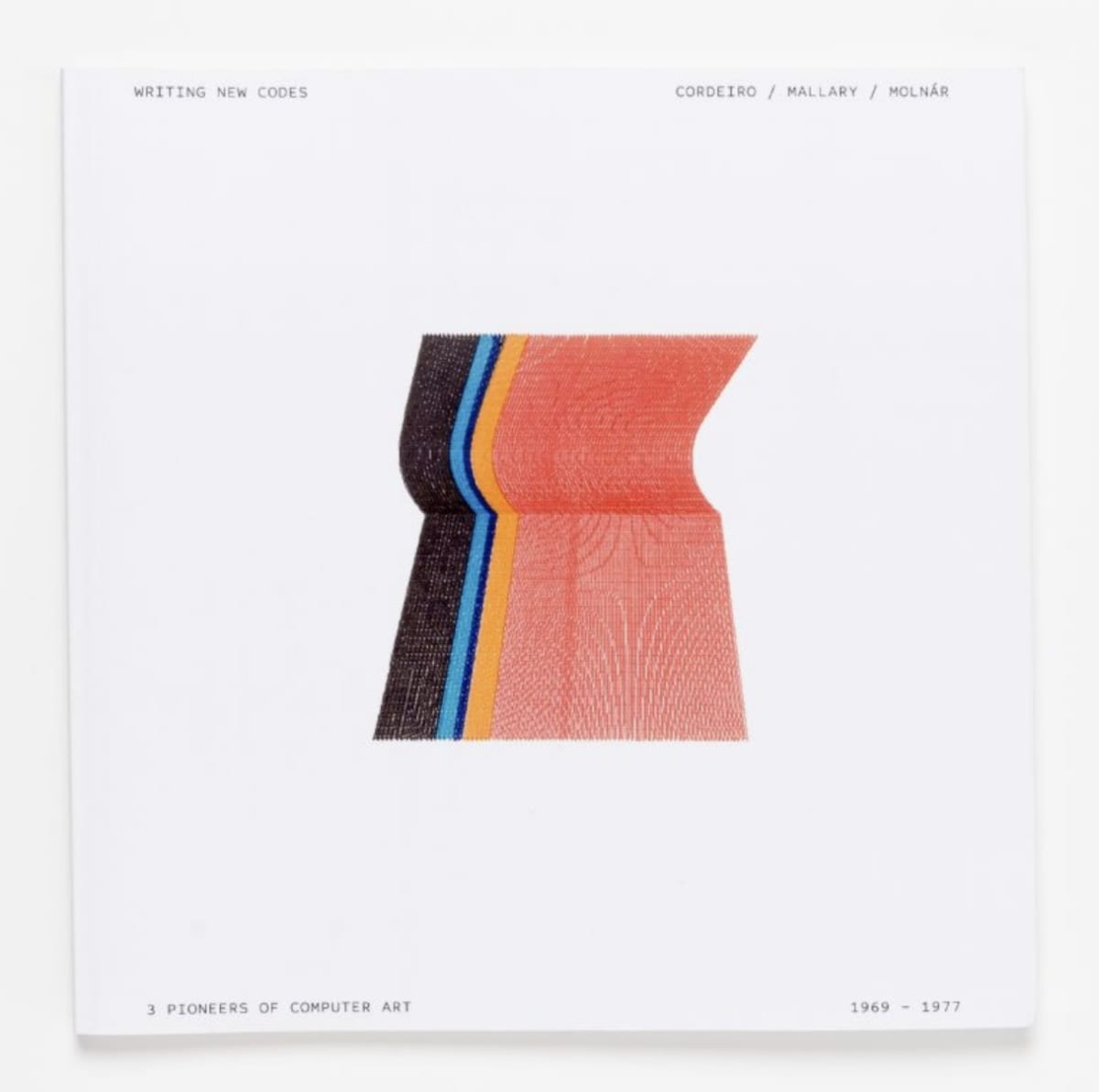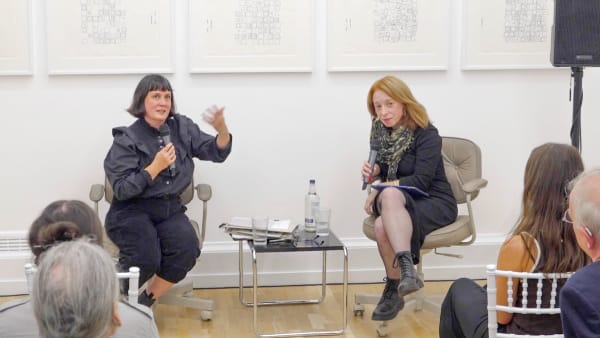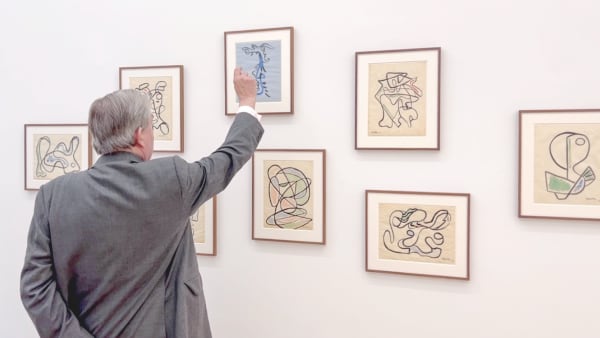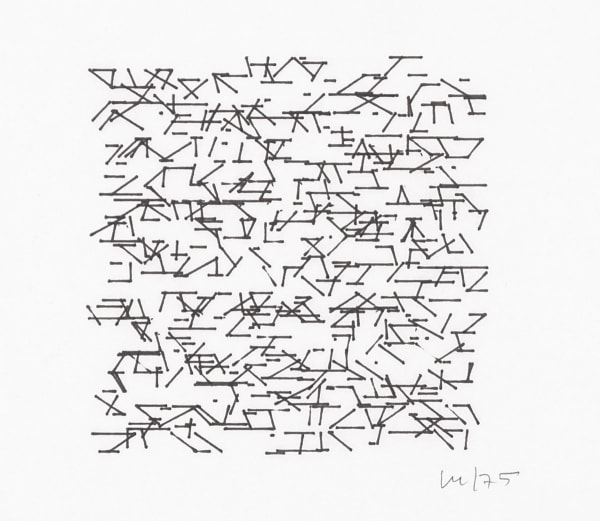Vera Molnár Hungarian, 1924-2023
Molnar (b. 1924 Budapest, Hungary - d. 2023 Paris, France) studied art history and aesthetics at the Budapest College of Fine Arts before moving to Paris in 1947 meeting Constructivist artists such as Jesus Rafael Soto and Victor Vasarely who shared an interest in exploring compositions based on simple geometric shapes and themes.
A co-founder of GRAV (Groupe de Recherche d’Art Visuel), 1960, including Julio le Parc and Francois Morellet, they investigated collaborative approaches to mechanical and kinetic art. Molnar was always fixated on geometric forms and creating system-based art. ‘My life is squares, triangles, lines. I am mad about lines.’
Pre-dating the computer, she invented algorithms or “machine imaginaire” that created images by following a set of pre-ordained compositional rules creating colourful abstract geometric works. Her breakthrough came in 1968 when she gained access to a computer at a research lab after teaching herself the early programming language of Fortran and could now program endless variations of algorithms through a machine. A laborious process, Molnar, using a language of 0s and 1s, fed the commands into the computer on punched cards or paper tape which were then outputted to a plotter which conveyed the image directly to paper via a moving pen or pencil. This method allowed her to investigate endless variations in geometric shape and line.
For her computer works, Molnar participated in the now legendary exhibitions Konkrete Kunst, Zurich, 1960, mounted by Max Bill and Cybernetic Serendipity at the ICA, London, 1968. Recent exhibitions include; MOMA New York, Thinking Machines: Art and Design in the Computer Age, 1959–1989, Artistes & Robots at the Grand-Palais, Paris and Chance and Control: Art in the Age of Computers at the Victoria & Albert Museum; all in 2018.
-
 Vera MolnárUntitled (MV528) Transformation of squares, 1975Computer plotter drawing on Benson paper36 x 55 cm
Vera MolnárUntitled (MV528) Transformation of squares, 1975Computer plotter drawing on Benson paper36 x 55 cm
14 1/8 x 21 5/8 inches -
 Vera MolnárUntitled (MV457-1) Génèse du Trapèze, 1974Computer plotter drawing on Benson paper36 x 55 cm
Vera MolnárUntitled (MV457-1) Génèse du Trapèze, 1974Computer plotter drawing on Benson paper36 x 55 cm
14 1/8 x 21 5/8 inches -
 Vera MolnárUntitled (MV457-2) Génèse du Trapèze, 1974Computer plotter drawing on Benson paper36 x 55 cm
Vera MolnárUntitled (MV457-2) Génèse du Trapèze, 1974Computer plotter drawing on Benson paper36 x 55 cm
14 1/8 x 21 5/8 inches -
 Vera MolnárUntitled (MV457-3) Génèse du Trapèze, 1974Computer plotter drawing on Benson paper36 x 55 cm
Vera MolnárUntitled (MV457-3) Génèse du Trapèze, 1974Computer plotter drawing on Benson paper36 x 55 cm
14 1/8 x 21 5/8 inches -
 Vera MolnárUntitled (MV457-4) Génèse du Trapèze, 1974Computer plotter drawing on Benson paper36 x 55 cm
Vera MolnárUntitled (MV457-4) Génèse du Trapèze, 1974Computer plotter drawing on Benson paper36 x 55 cm
14 1/8 x 21 5/8 inches -
 Vera MolnárUntitled (MV457-5) Génèse du Trapèze, 1974Computer plotter drawing on Benson paper36 x 55 cm
Vera MolnárUntitled (MV457-5) Génèse du Trapèze, 1974Computer plotter drawing on Benson paper36 x 55 cm
14 1/8 x 21 5/8 inches -
 Vera MolnárUntitled (MV532) Transformation of Squares, 1974Computer plotter drawing on Benson paper36 x 55 cm
Vera MolnárUntitled (MV532) Transformation of Squares, 1974Computer plotter drawing on Benson paper36 x 55 cm
14 1/8 x 21 5/8 inches -
 Vera MolnárUntitled (MV577A) Carrés concentriques, 1974Computer plotter drawing on Benson paper55 x 36 cm
Vera MolnárUntitled (MV577A) Carrés concentriques, 1974Computer plotter drawing on Benson paper55 x 36 cm
21 5/8 x 14 1/8 inches -
 Vera MolnárUntitled (MV578A) Carrés concentriques, 1974Computer plotter drawing on Benson paper55 x 36 cm
Vera MolnárUntitled (MV578A) Carrés concentriques, 1974Computer plotter drawing on Benson paper55 x 36 cm
21 5/8 x 14 1/8 inches -
 Vera MolnárUntitled (MV579A) - Carrés concentriques, 1974Computer plotter drawing on Benson paper55 x 36 cm
Vera MolnárUntitled (MV579A) - Carrés concentriques, 1974Computer plotter drawing on Benson paper55 x 36 cm
21 5/8 x 14 1/8 inches -
 Vera MolnárHommage à Mondrian, 1973Computer plotter drawing on Benson paper36 x 44 cm
Vera MolnárHommage à Mondrian, 1973Computer plotter drawing on Benson paper36 x 44 cm
14 1/8 x 17 3/8 inches -
 Vera Molnár(MV478B) Divergent lines, 1972Computer plotter drawing on Benson paper47 x 36 cm
Vera Molnár(MV478B) Divergent lines, 1972Computer plotter drawing on Benson paper47 x 36 cm
18 1/2 x 14 1/8 inches -
 Vera MolnárUntitled (5), 1972Computer plotter drawing, ink on paper30 x 30 cm
Vera MolnárUntitled (5), 1972Computer plotter drawing, ink on paper30 x 30 cm
11 3/4 x 11 3/4 inches -
 Vera MolnárUntitled (6), 1972Computer plotter drawing, ink on paper30 x 30 cm
Vera MolnárUntitled (6), 1972Computer plotter drawing, ink on paper30 x 30 cm
11 3/4 x 11 3/4 inches -
 Vera MolnárUntitled (7), 1972Computer plotter drawing, ink on paper30 x 30 cm
Vera MolnárUntitled (7), 1972Computer plotter drawing, ink on paper30 x 30 cm
11 3/4 x 11 3/4 inches -
 Vera MolnárInclinaisons 32 , 1971Computer plotter drawing on Benson paper36 x 30.5 cm
Vera MolnárInclinaisons 32 , 1971Computer plotter drawing on Benson paper36 x 30.5 cm
14 1/8 x 12 inches
-

Arteonics
27 Nov 2024 - 31 Jan 2025Building on the success of our 2018 exhibition Writing New Codes, and coinciding with Electric Dreams, at Tate Modern (28 Nov - 1 Jun 2025), The Mayor Gallery is excited...Read more -

Marlow Moss / Vera Molnár
New Angles 4 Sep - 1 Oct 2024The Mayor Gallery announces our forthcoming duo exhibition featuring the works of first British Constructivist artist Marlow Moss (1889 Kilburn, London - 1958 Penzance, Cornwall) and Hungarian pioneer of computer...Read more -

Women of Influence
1 Oct - 25 Nov 2022Marina Apollonio Emmy Bridgwater Feliza Bursztyn Dadamaino Ferdi Gego Verena Loewensberg Aiko Miyawaki Vera Molnar Marlow Moss Cornelia Parker Alice Rahon Mira Schendel Grazia Varisco Nanda VigoRead more -

Repetitions
2 Mar - 6 May 2022On the 100th anniversary of Répétitions by Paul Eluard and Max Ernst, a publication of collages and poems by the Dada and Surrealist artists, The Mayor Gallery in the countdown...Read more -

Writing New Codes
Cordeiro / Mallary / Molnár 6 Jun - 27 Jul 2018‘Writing New Codes’ presents three major pioneers of computer art – Waldemar Cordeiro (b. 1925 Rome, Italy – d. 1973 São Paulo, Brazil), Robert Mallary (b. 1917 Toledo, USA –...Read more
-

Watch: In Conversation, Lucy Howarth and Francesca Franco
November 9, 2024On the occasion of our past show 'Marlow Moss / Vera Molnár : New Angles' The Mayor Gallery played host to a special talk with...Read more -

Conversation with Lucy Howarth and Francesca Franco
Exhibition Event September 15, 2024Tuesday, 24 Sept, 5.30pm On the occasion of our current show Marlow Moss / Vera Molnár : New Angles we will play host to a...Read more -

Walk-Around | Marlow Moss / Vera Molnár : New Angles
With James Mayor September 10, 2024View an in-depth tour of Marlow Moss / Vera Molnár : New Angles conducted by James Mayor. View HereRead more -

Vera Molnár
Centre Pompidou, Paris February 19, 202428 Feb - 26 Aug 2024 Vera Molnár (born in Budapest in 1924 and living in Paris since 1947), who died on December 7, 2023...Read more
-

Vera Molnár
(1924 - 2023) December 8, 2023It is with great sadness we share the news of the Computer Art legend Vera Molnár’s passing at 99 years. Vera Molnar born in 1924...Read more -

Vera Molnár
Accademia d'Ungheria in Roma curated by Francesca Franco November 29, 2023Vera Molnár: VARIAZIONI ICÔNE opens at the Accademia d’Ungheria in Rome curated by Francesca Franco. The Mayor Gallery has contributed several works for this show...Read more -

NOT A DAY WITHOUT LINE
MUSEUM RITTER, GERMANY April 4, 2022Ends 24 April 2022 A first draft, a small sketch, a jotted-down thought: the line is regarded as the origin of every artistic idea, captured...Read more -

VERA MOLNAR
LE MUSÉE DES BEAUX-ARTS, RENNES November 24, 20219 OCT 2021 - 2 JAN 2022 The Musée des Beaux-Arts in Rennes is holding a major monographic exhibition dedicated to Vera Molnar and produced...Read more
-

Verena Loewensberg, Vera Molnar
'Women in Abstraction', Centre Pompidou May 19, 202119 May - 23 August 2021 Verena Loewensberg and Vera Molnar feature in Women in Abstraction at the Centre Pompidou, Paris. The exhibition sets out...Read more -

VERA MOLNÁR
CENTRE POMPIDU, PARIS June 19, 2018As part of a new exhibition that looks back at the history of the digital code and the way artists have used it since computers...Read more -

VERA MOLNÁR
INTERVIEW WITH STUDIO INTERNATIONAL June 7, 2018‘I have no regrets. My life is squares, triangles, lines’ The pioneer of computer-assisted art recounts her love affair with lines, the balancing of order...Read more


































